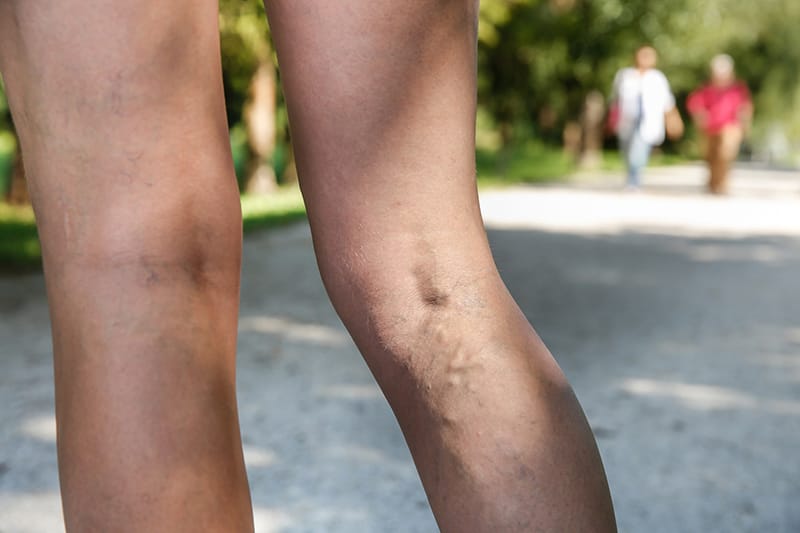Varicose veins are more common than you think. Nearly a quarter of adults have the condition. Due to their unsightly appearance, it’s probably one you may not often see despite its prevalence. Developing large, twisted, and sometimes colorful cords on the legs leads many people to cover up or seek treatment options to remove varicose veins entirely.
While common, varicose veins do more harm to your appearance and self-esteem than your health. They primarily affect the superficial veins in your legs. You may experience some aches, pains, swelling or skin discoloration. And in some cases, you may develop blood clots in your legs.
If you have concerns about your varicose veins, fill out this vein assessment and we’ll be in touch.
Blood clots? That sounds like a pretty big problem.
Rarely. Since most varicose veins are in the superficial veins, most blood clots form there, too. These veins are located just below the surface of the skin. So when a blood clot forms, your skin appears red, swollen and painful. This condition, known as superficial venous thrombosis, is directly correlated to varicose veins, but most people never get it.
That’s a relief. But how do you get superficial thrombophlebitis?
Superficial thrombophlebitis occurs when you have an injury. Even a slight injury to a varicose vein can cause it to become inflamed. That sudden inflammation in the vein causes blood flow to slow down and blood clots to form. And that’s a problem in the superficial veins.
Unlike deeper blood vessels, superficial veins aren’t surrounded by muscle. Muscles act as pumps for your veins. Without a pump to move it out, a blood clot can stick to the wall of your vein and be hard to dislodge. Your varicose vein feels like a hard cord and becomes painful.
Fortunately, the problem usually goes away on its own. In a few days, your inflammation should decrease. After a few weeks, the hardness of your vein subsides. Applying a warm compress and taking aspirin can ease your pain and symptoms until the problem is resolved.
What if you get a blood clot in a deeper vein?
That’s a much bigger issue. Severe varicose veins can affect the deeper veins, too. While there’s still research to be done, a study published in the Journal of the American Medical Association shows that people with varicose veins are five times more likely to develop deep vein thrombosis (DVT). We recommend anyone having doubts about their vein health to fill out our vein assessment.
DVT is similar to superficial thrombophlebitis, but the blood clot forms in a deeper, larger vein. And those are bigger vessels that carry more blood and connect to other parts of the body. If your muscles squeeze one of these blood clots out of your leg, there’s a chance it could land elsewhere and do much more damage.
When a blood clot breaks free and enters your lungs, it causes a life-threatening condition known as a pulmonary embolism. Without emergency medical attention, a pulmonary embolism can be deadly.
How do you tell the difference between a blood clot in a superficial vein and one in a deep leg vein?
A vein specialist can spot superficial thrombophlebitis on appearance alone. The skin over the clotted vein is red, warm, and tender to the touch.
Diagnosing deep vein thrombosis is a little trickier. Some people experience no symptoms. And other symptoms are similar to superficial thrombophlebitis. If you have varicose veins, look for these signs of DVT:
- Swelling
- Tenderness
- Pain in your calf, foot or leg
- Skin that is warm, red, or discolored
- Sudden leg fatigue
The differences between the two conditions are subtle. If you think you have a blood clot in your leg or you aren’t sure if it’s superficial or deep, you’ll want to see a vascular surgeon for an accurate diagnosis. For superficial thrombophlebitis, you’ll have peace of mind a few simple home remedies. For the more serious DVT, your vascular surgeon will prescribe the best treatment.
Varicose Veins Causing Problems? You’re Not Alone
While varicose veins are not necessarily a sign of trouble, you still have options available to reduce their appearance. We recommend completing our vein assessment form to start a conversation with one of our specialists and learn more about your available options.
And if you are experiencing any discomfort, pain or other signs of a more serious vascular condition, you can use the above form to reach out right away to get checked out.
